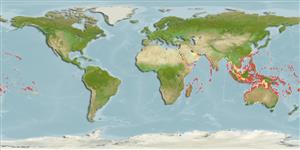Classification / Names
Common names from other countries
Main reference
Size / Weight / Age
Max length : 60.0 cm TL male/unsexed; (Ref. 11441); common length : 40.0 cm TL male/unsexed; (Ref. 5450)
Length at first maturity
Lm ?, range 22 - ? cm
Environment
Marine; reef-associated; non-migratory; depth range 1 - 40 m (Ref. 37816), usually 1 - 15 m (Ref. 90102)
Climate / Range
Tropical; 24°C - 28°C, preferred 27°C (Ref. 107945); 29°N - 34°S, 33°E - 122°W (Ref. 5222)
Distribution
Indo-Pacific: Red Sea to Durban, South Africa and eastward to French Polynesia and the Pitcairn group, north to the Ryukyu and Ogasawara islands, south to northern Australia and Lord Howe Island. May be confused with Cephalopholis cyanostigma.
Countries | FAO areas | Ecosystems | Occurrences | Introductions
Short description
Dorsal
spines
(total): 9;
Dorsal
soft rays
(total): 15-17;
Anal
spines: 3;
Anal
soft rays: 9. Dark brown in color, with small black-edged ocelli; 5-6 pale bars on rear part of body; large pale area over chest; distal part of pectorals sometimes maroon brown; triangular membranes at tips of dorsal fin spines orange-gold in color; further characterized by having ctenoid scales, becoming cycloid ventrally on belly; greatest body depth 2.7-3.3 in SL; rounded caudal fin; short pelvic fin, 1.9-2.4 in head length (Ref. 90102); head length 2.4-2.7 times in SL; small eyes, diameter less than snout length; interorbital area flat to slightly convex; rounded preopercle, finely serrate in young, virtually smooth in large adults, lower edge fleshy; smooth subopercle and interopercle; scaly maxilla, reaching well past eye (Ref. 89707).
IUCN Red List Status (Ref. 115185)
Threat to humans
Reports of ciguatera poisoning (Ref. 4690)
Human uses
Fisheries: commercial; gamefish: yes; aquarium: commercial
More information
ReferencesAquacultureAquaculture profileStrainsGeneticsAllele frequenciesHeritabilityDiseasesProcessingMass conversion
Tools
Special reports
Download XML
Internet sources
Estimates of some properties based on models
Phylogenetic diversity index
PD50 = 0.5000 many relatives (e.g. carps) 0.5 - 2.0 few relatives (e.g. lungfishes)
Trophic Level
4.5 ±0.0 se; Based on diet studies.
Resilience
Medium, minimum population doubling time 1.4 - 4.4 years (Preliminary K or Fecundity.)
Vulnerability
Moderate to high vulnerability (49 of 100)
Price category
